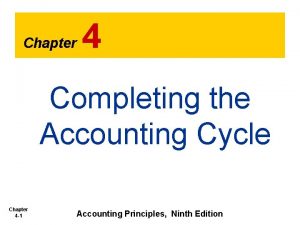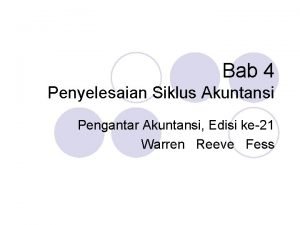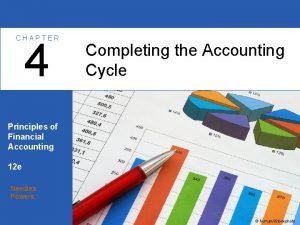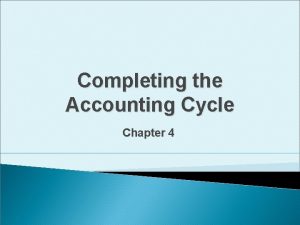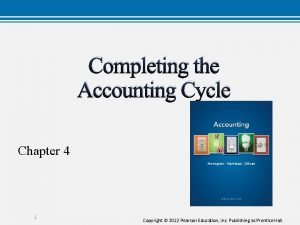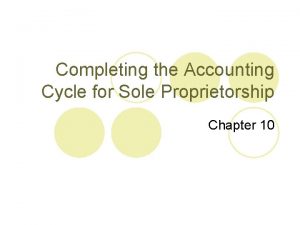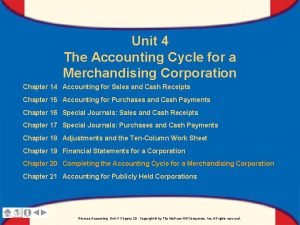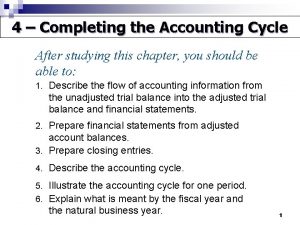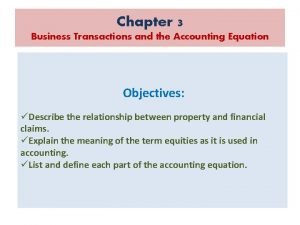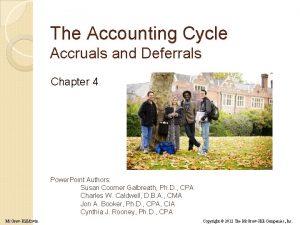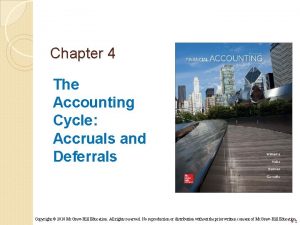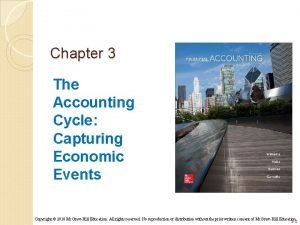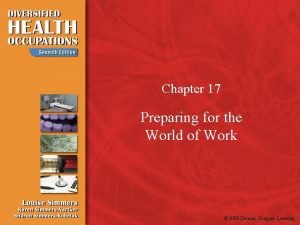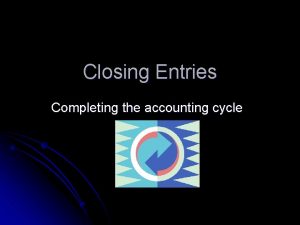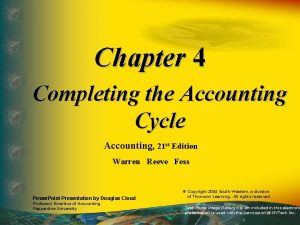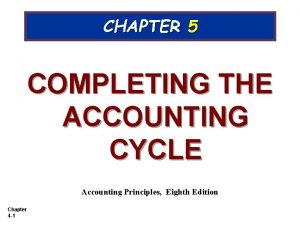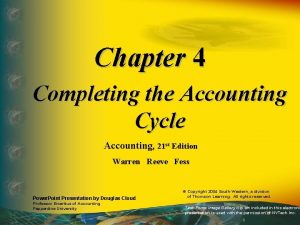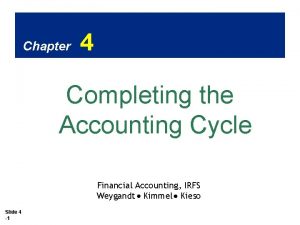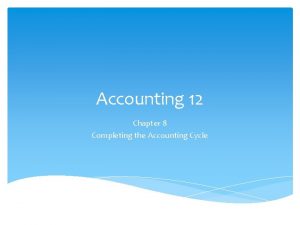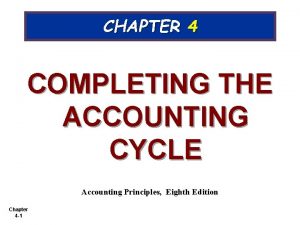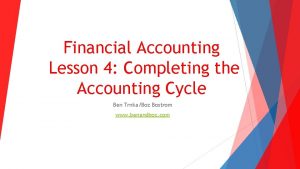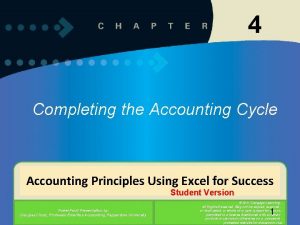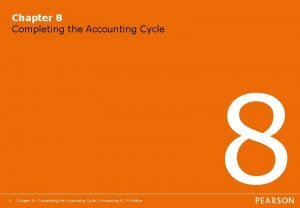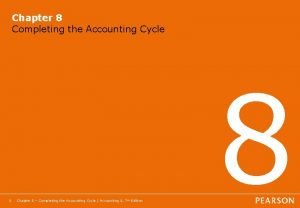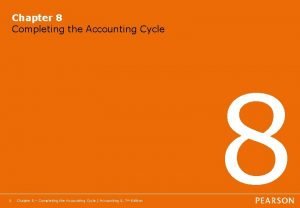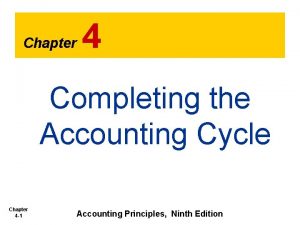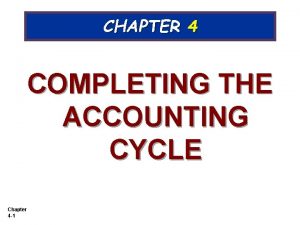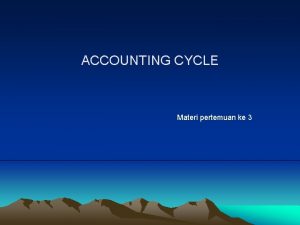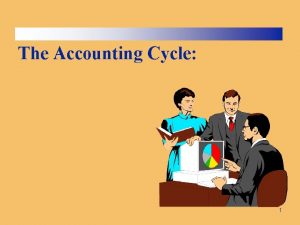Chapter 4 Completing the Accounting Cycle Chapter 4





























- Slides: 29

Chapter 4 Completing the Accounting Cycle Chapter 4 -1 Accounting Principles, Ninth Edition

READ CH 4 Read CH 4 & DO: ONLINE QUESTIONS on website • REMEMBER: 80 or better = 100 on HW ONLY. • < 80, you get actual score bc I want you to try on it. • You can do HW multiple times online Chapter 4 -2

Summary of the Accounting Cycle- This is all in the CH 4 outline on my site 1. Analyze business transactions Chapter 4 -3 Illustration 4 -12 9. Prepare a post-closing trial balance 2. Journalize the transactions 8. Journalize and post closing entries 3. Post to ledger accounts 7. Prepare financial statements 4. Prepare a trial balance 6. Prepare an adjusted trial balance 5. Journalize and post adjusting entries SO 4 State the required steps in the accounting cycle.

l Chapter 4 -4 GOAL: TO UNDERSTAND WHAT CLOSING ENTRIES ARE AND HOW TO JOURNAL THEM

Closing the Books-OPEN CH 4 CLOSING ENTRIES CHEAT SHEET Closing entries formally recognize, in the general ledger, the transfer of net income (or net loss) and owner’s drawing to owner’s capital. Closing entries are only at the end of the annual accounting period. Chapter 4 -5 SO 2 Explain the process of closing the books.

Closing the Books At the end of the accounting period, the company makes the accounts ready for the next period. Illustration 4 -5 Chapter 4 -6 SO 2 Explain the process of closing the books.

Purpose l Each Expense, Withdrawal, and Revenue account must start the new accounting period (fiscal) with a zero balance l Similar to a basketball, etc game, you start the score at zero Chapter 4 -7

Income Summary l l Chapter 4 -8 Temporary account It does not have an official balance side. It does not have an increase or decrease side It just summarizes the net income or net loss for a fiscal period

List the 3 temporary accounts that get closed Chapter 4 -9

In summary, there are four steps involved in closing the books: 1. Close the revenue accounts into Income Summary. 2. Close the expense accounts into Income Summary. 3. Close Income Summary into Capital. 4. Close Drawings into Capital. Chapter 4 -10

Income Summary Used to accumulate and summarize the revenue and expenses for the period STEP 1: Revenues (CREDIT balances) are transferred as credit in Income Summary l l Then the Revenue Account is closed by a Debit revenue Income summary Db XX CR xx STEP 2: Expenses (DEBIT balances) are transferred as debits in Income summary l Then the Expense Account is closed by a Credit Db Income summary XX expense Chapter 4 -11 CR xx

Income Summary STEP 3. Close the Income Summary to the Owners Capital as a Net Income or Net Loss l Take the Difference between Revenue & Expenses & transfer it to Capital- CHOOSE A OR B A. B. Chapter 4 -12 If the income summary has a credit balance (more credit then debit) then transfer it to Capital as a credit- b/c you are increasing capital. Then put a debit for Income Summary Db Income summary XX capital CR Db Capital XX Income Summary CR XX If the income summary has a debit balance (more debit then credit) then transfer it to Capital as a debit- b/c you are decreasing capital. Then put a credit for Income Summary XX

Withdrawals STEP 4: Close Withdrawals (Owner’s Drawing) to the Owners Capital Account l Owner’s Capital is debited & the Owner’s Drawing account is closed with a credit Db XX Capital Drawing Chapter 4 -13 CR XX

In summary, there are four steps involved in closing the books: 1. Close the revenue accounts into Income Summary. 2. Close the expense accounts into Income Summary. 3. Close Income Summary into Capital. 4. Close Drawings into Capital. Chapter 4 -14

Preparing a Post-Closing Trial Balance Purpose is to prove the equality of the permanent account balances after journalizing and posting of closing entries. All temporary accounts (revenue, expenses & drawing) will have zero balances. ONLY CAPITAL IS AFFECTED Chapter 4 -15 SO 3 Describe the content and purpose of a post-closing trial balance.

Closing the Books Note: Owner’s Drawing is closed directly to Capital and not to Income Summary because Owner’s Drawing is not an expense. Chapter 4 -16 Illustration 4 -6 Owner’s Capital is a permanent account; all other accounts are temporary accounts. SO 2 Explain the process of closing the books.

The ledger of Swann Company contains the following ledger balances: Service Revenue $50, 000 l Salaries Expense $27, 000 l Supplies Expense $4, 000 l Swann, Drawing $2, 000 Hint: Prepare closing JOURNAL entries at 12/31 from ledger balances. Use CHEAT SHEET l Chapter 4 -17 Dec. 31 debit credit Service Revenue 50, 000 Income Summary 50, 000 Income Summary 31, 000 Salaries Expense 27, 000 Supplies Expense 4, 000 Income Summary 19, 000 Swann, Capital 19, 000 Swann, Capital 2, 000 Swann, Drawing 2, 000

Your turn The ledgers contains the following ledger balances: Service Revenue $18, 100 l Salaries Expense $8, 800 l Supplies Expense $1, 300 l Rent Expense $3, 000 l D. Swann, Drawing $2, 500 Prepare the closing entries at December 31. Hint: Prepare closing JOURNAL entries from ledger balances. Use CHEAT SHEET l Chapter 4 -18

CLOSING ENTRIES PRACTICE The ledgers contains the following ledger balances: Service Revenue $16, 100 l Salaries Expense $7, 800 l Supplies Expense $2, 300 l Rent Expense $5, 000 l D. Swann, Drawing $3, 500 Prepare ALL THE Closing Entries Hint: Use CHEAT SHEET l Chapter 4 -19

l Chapter 4 -20 GOAL: TO UNDERSTAND THE PURPOSE OF A CLASSIFIED BALANCE SHEET

The Classified Balance Sheet- OPEN CH 4 OUTLINE Presents a snapshot at a point in time. To improve understanding, companies group similar assets and similar liabilities together. Standard Classifications Illustration 4 -17 Assets Liabilities and Owner’s Equity Current assets (< 1 yr) Long-term investments (>1 yr) Property, plant, and equipment Intangible assets Current liabilities (< 1 yr) Long-term liabilities (>1 yr) Owner’s (Stockholders’) equity Chapter 4 -21 SO 6 Identify the sections of a classified balance sheet.

The Classified Balance Sheet- NOTICE THE SEQUENCE OF HOW THEY ARE LISTED. #18 OF OUTLINE Current Assets: Assets that a company expects to convert to cash or use up within one year Chapter 4 -22 Companies usually list current asset accounts in the order they expect to convert them into cash.

The Classified Balance Sheet Review Question Cash, and other resources that are reasonably expected to be realized in cash or sold or consumed in the business within one year or the operating cycle, are called: a. Current assets. b. Intangible assets. c. Long-term investments. d. Property, plant, and equipment. Chapter 4 -23 SO 6 Identify the sections of a classified balance sheet.

The Classified Balance Sheet - #23 in OUTLINE Current Liabilities: Obligations the company is to pay within the coming year. Chapter 4 -24 SO 6 Identify the sections of a classified balance sheet.

The Classified Balance Sheet Review Question Which of the following is a current liability? a. Bonds payable b. Notes Payable c. Long-term notes payable d. Mortgages payable Chapter 4 -25 SO 6 Identify the sections of a classified balance sheet.

BE 4 -10 The balance sheet debit column of the worksheet for Diaz Company includes the following accounts: • Accounts Receivable $12, 500 • Prepaid Insurance $3, 600 • Cash $15, 400 • Supplies $5, 200 • Short-term Investments $6, 700. In your notes, prepare the current assets section of the balance sheet, listing the accounts in proper sequence. HINT: use #18 of your CH 4 outline Chapter 4 -26

QUICK REVIEW: FIX THE TRIAL BALANCE (HINT Look at CH 2) Account Titles Cash Accounts Receivable Supplies Accounts Payable Unearned Service Revenue Owner's Capital Service Revenue Salaries and Wages Expense Miscellaneous Expense Dr. $2, 440 $1, 220 $560 $160 TOTALS Chapter 4 -27 $4, 380 Cr. $2, 420 $1, 880 $240 $3, 600 $2, 400 $10, 540

USING THE TERMS BELOW, Classify each of the following accounts as either: • Current assets (CA) • Property, plant, and equipment (PPE) • Current liabilities (CL) • Long-term liabilities (LTL) • Owner's equity (OE) Accounts payable Accounts receivable Cash Owner's capital Salaries and wages payable Inventory Buildings Notes payable (due in 2 years) Supplies Equipment Chapter 4 -28 Prepaid expenses

Steps in Preparing a Worksheet Illustration 4 -1 Chapter 4 -29 SO 1 Prepare a worksheet.
 Completion of the accounting cycle
Completion of the accounting cycle Chapter 4 completing the accounting cycle
Chapter 4 completing the accounting cycle Completing the accounting cycle chapter 4 pdf
Completing the accounting cycle chapter 4 pdf Chapter 4 completing the accounting cycle
Chapter 4 completing the accounting cycle Completing the accounting cycle chapter 4
Completing the accounting cycle chapter 4 Chapter 4 completing the accounting cycle
Chapter 4 completing the accounting cycle Journal entries of sole proprietorship
Journal entries of sole proprietorship Completing the accounting cycle of a merchandising business
Completing the accounting cycle of a merchandising business Post closing trial balance
Post closing trial balance Problem 5-8 completing the accounting equation
Problem 5-8 completing the accounting equation Intermediate accounting chapter 1
Intermediate accounting chapter 1 Chapter 4 the accounting cycle accruals and deferrals
Chapter 4 the accounting cycle accruals and deferrals Chapter 4 the accounting cycle accruals and deferrals
Chapter 4 the accounting cycle accruals and deferrals Chapter 3 accounting cycle
Chapter 3 accounting cycle Accounting cycle
Accounting cycle Chapter 5 two-cycle and four-cycle engines answers
Chapter 5 two-cycle and four-cycle engines answers Chapter 18.1 preparing for the world of work
Chapter 18.1 preparing for the world of work Chapter 18 preparing for the world of work
Chapter 18 preparing for the world of work Hình ảnh bộ gõ cơ thể búng tay
Hình ảnh bộ gõ cơ thể búng tay Bổ thể
Bổ thể Tỉ lệ cơ thể trẻ em
Tỉ lệ cơ thể trẻ em Chó sói
Chó sói Thang điểm glasgow
Thang điểm glasgow Chúa yêu trần thế alleluia
Chúa yêu trần thế alleluia Môn thể thao bắt đầu bằng chữ f
Môn thể thao bắt đầu bằng chữ f Thế nào là hệ số cao nhất
Thế nào là hệ số cao nhất Các châu lục và đại dương trên thế giới
Các châu lục và đại dương trên thế giới Công thức tiính động năng
Công thức tiính động năng Trời xanh đây là của chúng ta thể thơ
Trời xanh đây là của chúng ta thể thơ

